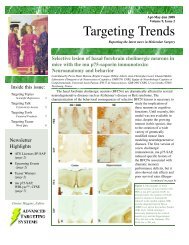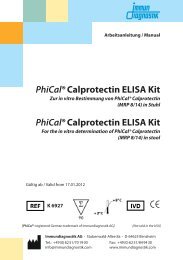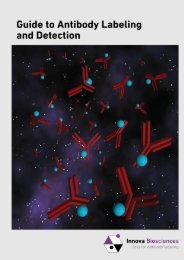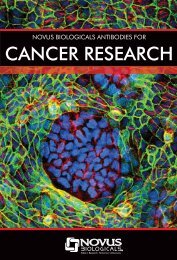Oncology Probes
Oncology Probes
Oncology Probes
- No tags were found...
Create successful ePaper yourself
Turn your PDF publications into a flip-book with our unique Google optimized e-Paper software.
ON BCL6 (3q27) BreakChromosomal translocations involving band 3q27 withvarious different partner chromosomes represent a recurrentcytogenetic abnormality in B-cell non-Hodgkin’s lymphoma.A FISH strategy using two differently labeled flanking BCL6probes provides a robust, sensitive, and reproducible methodfor the detection of common and uncommon abnormalities ofBCL6 gene in interphase nuclei. Kreatech has developed thisprobe for the specific use on cell material (KBI-10607), or forthe use on tissue (KBI-10730).Note: Two different breakpoint regions have been identified,the major breakpoint region (MBR) is located within the5’ noncoding region of the BCL6 proto-oncogene, while theatypical breakpoint region (ABR) is located approximately250 kb proximal to the BCL6 gene. The Poseidon BCL6 (3q27)is designed in a way to flank both possible breakpoints,thereby providing clear split signals in either case.ON MYC (8q24) Break, TCRearrangements of the protooncogene C-myc (or MYC) havebeen consistently found in tumor cells of patients sufferingfrom Burkitt’s lymphoma. In cases with the common t (8;14)chromosomal translocation, the c-myc gene is translocatedto chromosome 14 and rearranged with the immunoglobulinheavychain genes; the breakpoint occurs 5’ to the c-mycgene and may disrupt the gene itself separating part ofthe first untranslated exon from the remaining two codingexons. In Burkitt’s lymphoma showing the variant t (2;8)or t (8;22) translocations, the genes coding for the k and lmmunoglobulin light chain are translocated to chromosome8. The rearrangement takes place 3’ to the c-myc gene. At thepresent time the mechanism by which the oncogenic potentialof the c-myc gene may be activated by these rearrangementsis still controversial.The MYC (8q24) break-apart probe is optimized to detectrearrangements involving the 8q24 locus in a triple-color, splitassay on metaphase/interphase spreads, blood smears andbone marrow cells.Cat.# KBI-10607 BCL6 (3q27)Cat.# KBI-10611 MYC (8q24) Break, TCD8S1813D3S4060550 KB878 KBRH77966D8S1017BCL6ABR*MBR*MYC740 KB350 KB8q24RH750253q27D3S32458D8S1128866 KB<strong>Oncology</strong> <strong>Probes</strong> - Hematology <strong>Probes</strong>443ABR* atypical breakpoint regionMBR* major breakpoint regionBCL6 (3q27) Break probe hybridized to patient material (1RG1R1G).Image kindly provided by Prof Siebert, KielLiterature:Butler et al, 2002, Cancer Res, 62; 4089-4094.Sanchez-Izquierdo, 2001, Leukemia, 15; 1475-1484.Ordering information Color Tests Cat#ON BCL6 (3q27) Break red/green 10 KBI-10607SHG 172475MYC (8q24) Break probe hybridized to patient material showing a8q24 proximal break (1GBR1G1BR).Image kindly provided by Prof. Siebert, Kiel.Literature:Fabris et al, 2003, Genes Chromosomes Cancer 37 ; 261-269Hummel et al., 2006, N Engl J Med 354 ;2419-30.Ordering information Color Tests Cat#ON MYC (8q24) Break, TC red/green 10 KBI-10611
















